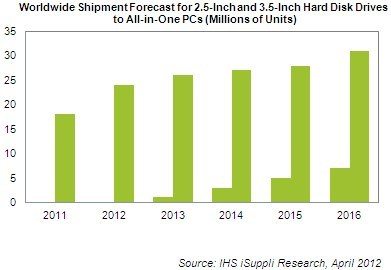2.5″ hard drives to take off in desktop PCs next year
Ryan Martin / 13 years ago

New demand from all-in-one desktop PCs combined with requirements for new processors, lower power consumption and a thinner, smaller storage alternative to existing 3.5-inch hard disc drives (HDD) will help create a viable market for 2.5-inch HDDs beginning next year, according to an IHS iSuppli Storage Space market brief from information and analysis provider IHS.Shipments of 2.5-inch HDDs to all-in-one PCs are forecast to reach approximately 1 million units in 2013, up from virtually zero this year. Shipments will then increase to 3 million units the following year and move up steadily until they hit some 7 million units in 2016. The HDD market for all-in-one PCs will continue to be dominated by 3.5-inch discs, with shipments by 2016 estimated at 31 million units, but growth will be much slower for the segment during the same period.
The 2.5-inch HDD is used widely today in a variety of products, including mobile or notebook PCs, external hard disk drives and enterprise applications such as servers and storage systems. Their advantages over conventional 3.5-inch HDDs include a smaller form factor, lower power consumption and higher endurance.Of late, however, the 2.5-inch drives have also become attractive and desirable for desktop PCs, especially among all-in-one computers. With maximum capacities of 1 terabyte, the drives are proving very attractive for all-in-one PC makers in their next-generation designs. All-in-one PCs that have the potential to adopt the 2.5-inch HDD as their storage medium include the iMac from Apple Inc., TouchSmart from Hewlett-Packard, Series 7 from Samsung Electronics, IdeaCentre from Lenovo, Top Touchscreen from Asus Eee, and all-in-one desktops from Vizio and Acer.
With demand for all-in-one desktop PCs expected to grow, future market prospects for the 2.5-inch HDD appear encouraging, IHS iSuppli believes. Compared to conventional desktop PCs, all-in-ones possess superior features and performance, brought about by advances in processors, the adoption of NAND flash and the thinner HDD size. As such, all-in-one desktop PCs can extend the current markets for 2.5-inch HDDs covering notebooks, external hard drives and the enterprise, allowing the thinner and smaller drives to penetrate the desktop space.Two disadvantages of the 2.5-inch HDD are speed and price. Most 2.5-inch drives typically run at 5,400 revolutions per minute (rpm), compared to 7,200 rpm for the 3.5-inch. The 2.5-inch also sells at slightly higher prices than the 3.5-inch as a whole, although the gap in price can be narrowed if 2.5-inch volumes become significant.
Nonetheless, enough positive factors are present to push growth overall for the 2.5-inch drives. As a result, the 2.5-inch will represent approximately 4 percent of the all-in-one desktop PC market by next year, and then go on to account for 18 percent of the all-in-one market by 2016. And as capacity and speed continue to improve and costs go down, the 2.5-inch HDD is expected to take share away from 3.5-inch HDDs in the traditional desktop PC market, IHS iSuppli predicts.The 2.5-inch hard disc can enjoy about four to five years of uninterrupted growth before low-priced, high-density solid state drives become competitive.
Source: PR



















